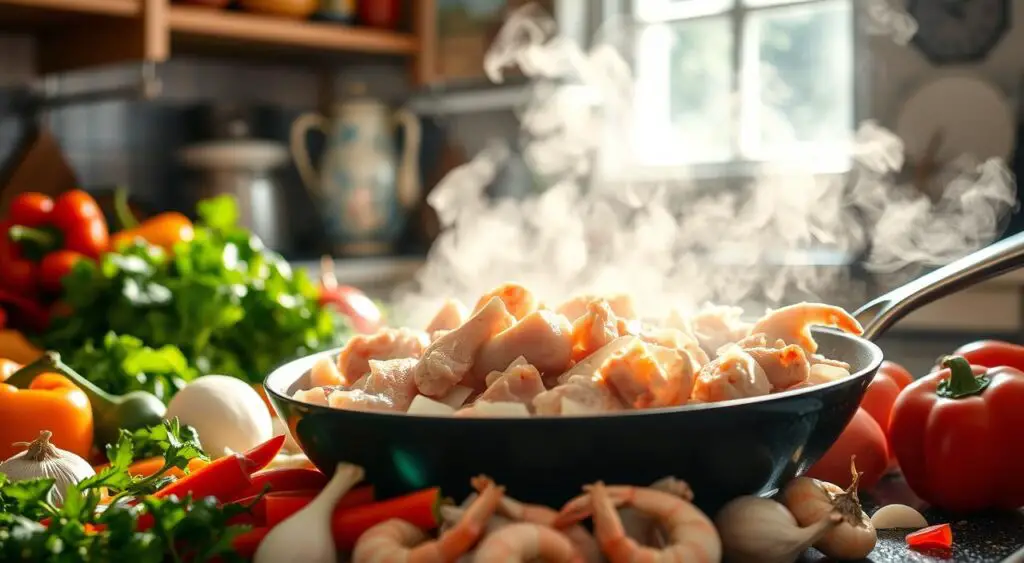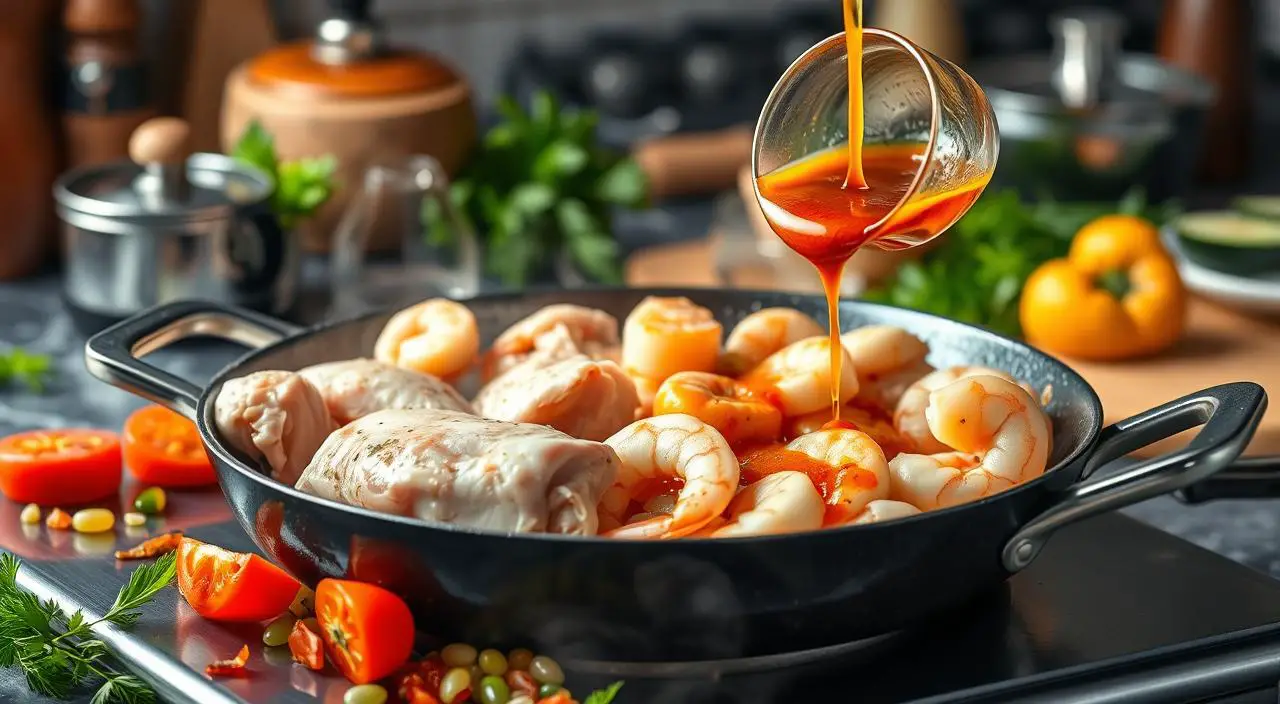Thinking about mixing raw chicken and shrimp in one dish might excite you. But, it’s important to know the food safety rules and cooking methods first. This guide will help you understand how to cook these proteins together safely and enjoyably.
Key Takeaways
- Understand the basic food safety principles when handling multiple proteins.
- Learn about the cross-contamination risks and temperature control essentials.
- Discover the proper cooking temperatures for both chicken and shrimp.
- Explore the benefits and drawbacks of cooking chicken and shrimp together.
- Uncover the best cooking methods and preparation techniques for this dynamic duo.
Understanding Food Safety When Combining Different Proteins
When we mix proteins like chicken and shrimp in our meals, we must be careful. We need to follow important food safety rules. This ensures our dishes are not only tasty but also safe and healthy.
Basic Food Safety Principles
Handling different proteins requires basic food safety steps. We should wash our hands well, clean all tools and surfaces, and keep raw foods away from cooked ones. By doing this, we lower the chance of food getting contaminated and keep everyone safe.
Cross-Contamination Risks
Cooking chicken and shrimp together can lead to cross-contamination. Raw chicken might have harmful bacteria like Salmonella. These can spread to other foods if we don’t handle them right. So, it’s key to use separate boards, knives, and areas for each raw protein.
Temperature Control Essentials
Keeping the right temperature is vital when cooking different protein cooking methods. Chicken and shrimp need to reach certain internal temperatures to be safe. Keeping the right temperature helps kill off any bad bacteria.
By knowing and using these food safety basics, we can enjoy making and eating chicken and shrimp dishes safely and with confidence.
Can You Cook Raw Chicken and Shrimp Together?
It’s possible to cook raw chicken and shrimp together, but it depends on how you do it. You must follow safe food practices to make sure your meal is both safe and tasty.
When cooking these two proteins together, remember their different cooking temperatures. Chicken must reach 165°F (74°C) to kill bacteria. Shrimp is done when it turns pink and looks opaque, usually at 120°F (49°C). You need to watch the cooking time closely to make sure both are cooked right.
| Protein | Minimum Internal Temperature |
|---|---|
| Chicken | 165°F (74°C) |
| Shrimp | 120°F (49°C) |
To cook chicken and shrimp safely together, follow these tips:
- Prepare the chicken and shrimp separately to avoid cross-contamination.
- Add the shrimp towards the end of the cooking time, allowing the chicken to reach its safe internal temperature first.
- Use a food thermometer to ensure both proteins are cooked to their respective safe minimum temperatures.
- Consider cooking the chicken and shrimp in separate pans or batches if you’re concerned about timing or temperature control.
By following these guidelines, you can cook raw chicken and shrimp together safely. This way, you can enjoy tasty protein combinations without risking food safety.
Safe Temperature Requirements for Chicken and Shrimp
It’s important to cook chicken and shrimp at the right temperature for food safety. Let’s look at the specific temperatures needed for these proteins.
Minimum Internal Temperature for Chicken
The USDA says chicken must be cooked to 165°F (74°C) to be safe. This kills harmful bacteria like Salmonella, making the chicken safe to eat.
Proper Cooking Temperature for Shrimp
Shrimp need to be cooked to 145°F (63°C). This temperature kills pathogens and keeps the shrimp tender and juicy.
Using Food Thermometers Correctly
To check the internal temperature of chicken and shrimp, use a food thermometer. Stick the thermometer into the thickest part, avoiding bones or fat. This ensures your dishes are cooked right and safe to eat.
| Protein | Minimum Internal Temperature |
|---|---|
| Chicken | 165°F (74°C) |
| Shrimp | 145°F (63°C) |
By following these safe cooking temperatures, we can make tasty and safe meals with chicken and shrimp.
Benefits and Drawbacks of Cooking Chicken and Shrimp Together
Cooking chicken and shrimp together can be tasty and efficient. But, it’s key to know the good and bad sides before trying it. Let’s dive into the benefits and drawbacks of this protein pairing.
One big plus is the chance to mix unique flavor combinations. Chicken’s savory taste can match shrimp’s sweet and briny flavor. This makes for a dish that’s both tasty and balanced. Plus, cooking both at once can save you time and effort in the kitchen.
But, there are some potential challenges to think about. Keeping the right temperature control and avoiding cross-contamination are important. Also, the texture differences between chicken and shrimp need careful attention. You must cook them right to avoid one being overcooked while the other is perfect.
“Balancing the flavors and textures when cooking chicken and shrimp together can be a delicate dance, but the rewards can be truly delightful if done well.”
Whether to cook chicken and shrimp together depends on your taste, cooking skills, and recipe. With the right food safety and a focus on balance, you can create delicious flavor combinations and enhanced cooking efficiency.

Best Cooking Methods for Combining Chicken and Shrimp
There are many ways to cook chicken and shrimp together. You can stir-fry, use one pan, or grill them. Each method has its own benefits and things to consider.
Stir-Frying Techniques
Stir-frying is fast and efficient. It seals in juices and prevents overcooking. Make sure all ingredients are ready, as cooking is quick.
Cook chicken and shrimp in batches. This ensures even browning and doneness.
One-Pan Cooking Guidelines
One-pan meals are easy and save on cleanup. They let the flavors of chicken and shrimp mix. Be careful with cooking times and add ingredients in the right order.
Stir often to prevent overcrowding. This helps in even cooking.
Grilling Tips
Grilling adds a smoky flavor. Use skewers or small pieces for even cooking. Watch the grill closely and use a thermometer to check temperatures.
Learning these techniques will help you make tasty chicken and shrimp dishes. They’re sure to impress your guests.
Proper Preparation and Handling Techniques
Cooking raw chicken and shrimp together requires careful food preparation and handling. Each step, from marinating to defrosting, affects the dish’s quality and safety.
Here are some key tips for safe food preparation and handling:
- Food Preparation: Clean all surfaces, utensils, and cutting boards before handling raw chicken and shrimp. This prevents cross-contamination and harmful bacteria spread.
- Marinating: Marinate chicken and shrimp separately to ensure food safety. Always discard the marinade after use, as it may contain harmful bacteria.
- Seasoning: Season chicken and shrimp separately with your favorite herbs and spices. This keeps flavors distinct and maintains food safety.
- Defrosting: Defrost chicken and shrimp in the refrigerator to keep them at a safe temperature. Never leave them at room temperature, as this can lead to bacterial growth.
By following these steps, you can prepare chicken and shrimp safely for a delicious meal.
| Preparation Step | Importance |
|---|---|
| Cleaning and Sanitizing | Prevents cross-contamination and the spread of harmful bacteria. |
| Separate Marinating | Ensures food safety by avoiding the mixing of raw proteins. |
| Distinct Seasoning | Preserves the individual flavors of the chicken and shrimp. |
| Proper Defrosting | Maintains safe temperatures and prevents bacterial growth. |
“Proper food preparation and handling is the foundation for a safe and delicious meal.”
Popular Recipes Combining Chicken and Shrimp
Chicken and shrimp together make for a culinary dream. They create dishes that range from spicy Cajun to fresh Mediterranean. Each blend offers a unique taste experience.
Cajun-Style Dishes
Cajun food is known for its bold flavors. Chicken and shrimp dishes like Jambalaya and Blackened Chicken and Shrimp are classics. They mix flavors and textures in a delicious way.
Asian-Inspired Combinations
Asian flavors pair well with chicken and shrimp. Recipes like Thai Coconut Curry and Kung Pao Chicken and Shrimp are perfect. They balance sweet, sour, and spicy beautifully.
Mediterranean Recipes
Mediterranean food is fresh and vibrant. Chicken and shrimp dishes like Souvlaki and Paella are highlights. They mix strong flavors with light, clean tastes.
Looking for a Cajun, Asian, or Mediterranean dish? Chicken and shrimp have you covered. They open up a world of flavors to try.
Time Management and Cooking Order
Mastering the art of cooking chicken and shrimp together needs good meal planning and knowing the cooking timelines. By planning the protein cooking order well, we can make sure our kitchen runs smoothly. This way, we can serve tasty meals without stress.
It’s important to think about how long each protein takes to cook. Chicken usually needs more time than shrimp. So, start cooking the chicken first. Then, add the shrimp towards the end.
- Start by cooking the chicken. Sear or bake it until it hits 165°F (74°C) inside.
- When the chicken is almost done, toss in the shrimp. Shrimp cook fast, so they’re ready in just a few minutes at 145°F (63°C).
- Staggering the cooking times helps both chicken and shrimp cook perfectly. This way, they’re ready to eat at the same time.
Using this cooking timeline method keeps food safe and makes meal prep quicker. Planning ahead and knowing the right cooking order saves time in the kitchen.
| Protein | Minimum Internal Temperature | Cooking Time |
|---|---|---|
| Chicken | 165°F (74°C) | 30-40 minutes |
| Shrimp | 145°F (63°C) | 3-5 minutes |
By sticking to these tips and optimizing your cooking order, you can make your kitchen more efficient. This way, you’ll always serve delicious, perfectly cooked chicken and shrimp dishes.
Common Mistakes to Avoid When Cooking Chicken and Shrimp
When cooking chicken and shrimp together, it’s key to avoid a few common mistakes. One big error is overcooking, which makes the proteins dry and tough. On the other hand, undercooking can be dangerous, as it might not kill harmful bacteria.
Seasoning is another area where we often go wrong. Getting the seasoning right is tricky, especially when mixing two proteins. It’s important to balance the flavors. Also, we must avoid cross-contamination by handling food safely and keeping it at the right temperature.
By being aware of these mistakes and following safe food handling practices, we can make our chicken and shrimp dishes much better. With a bit of care, we can create meals that taste like they came from a restaurant.

